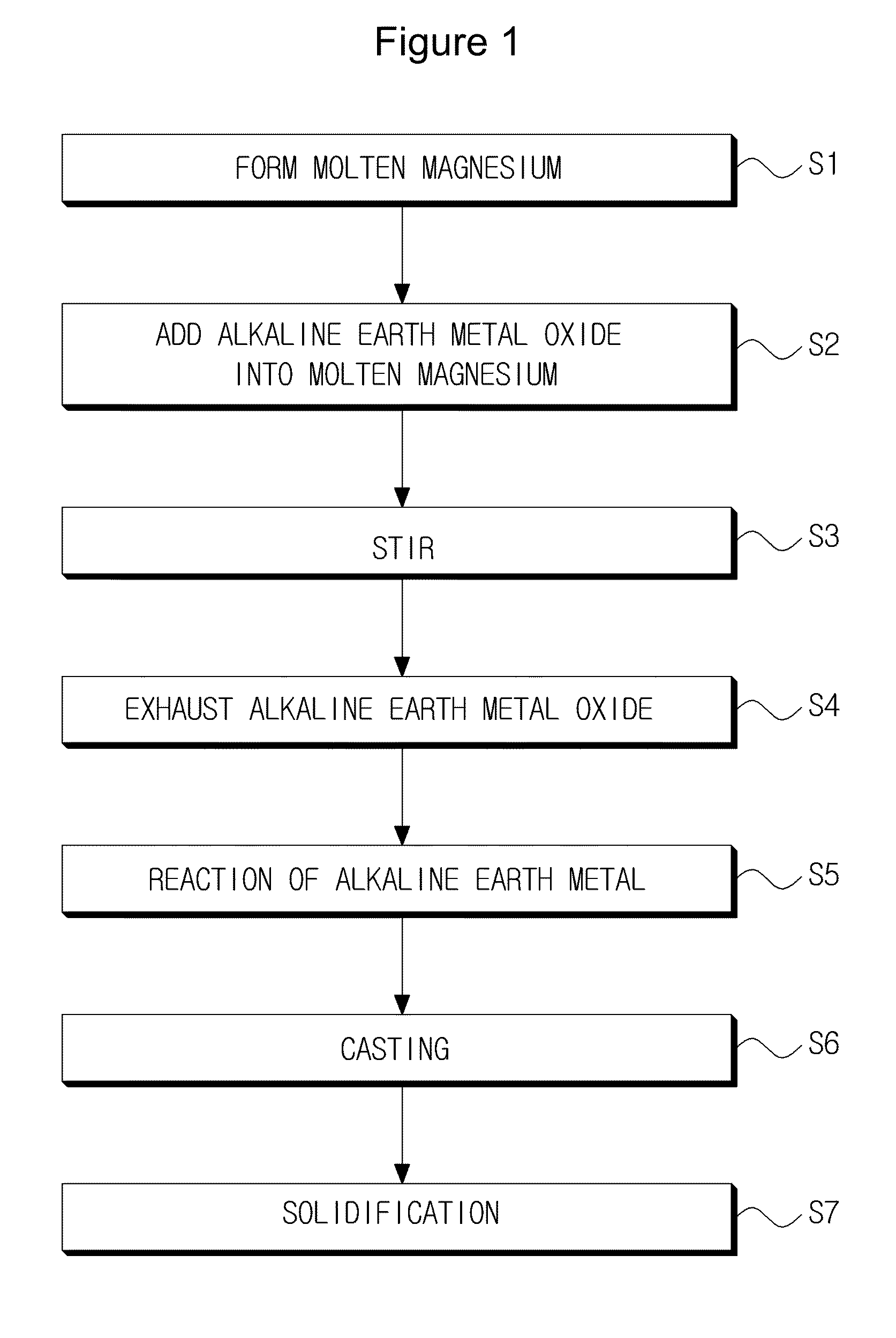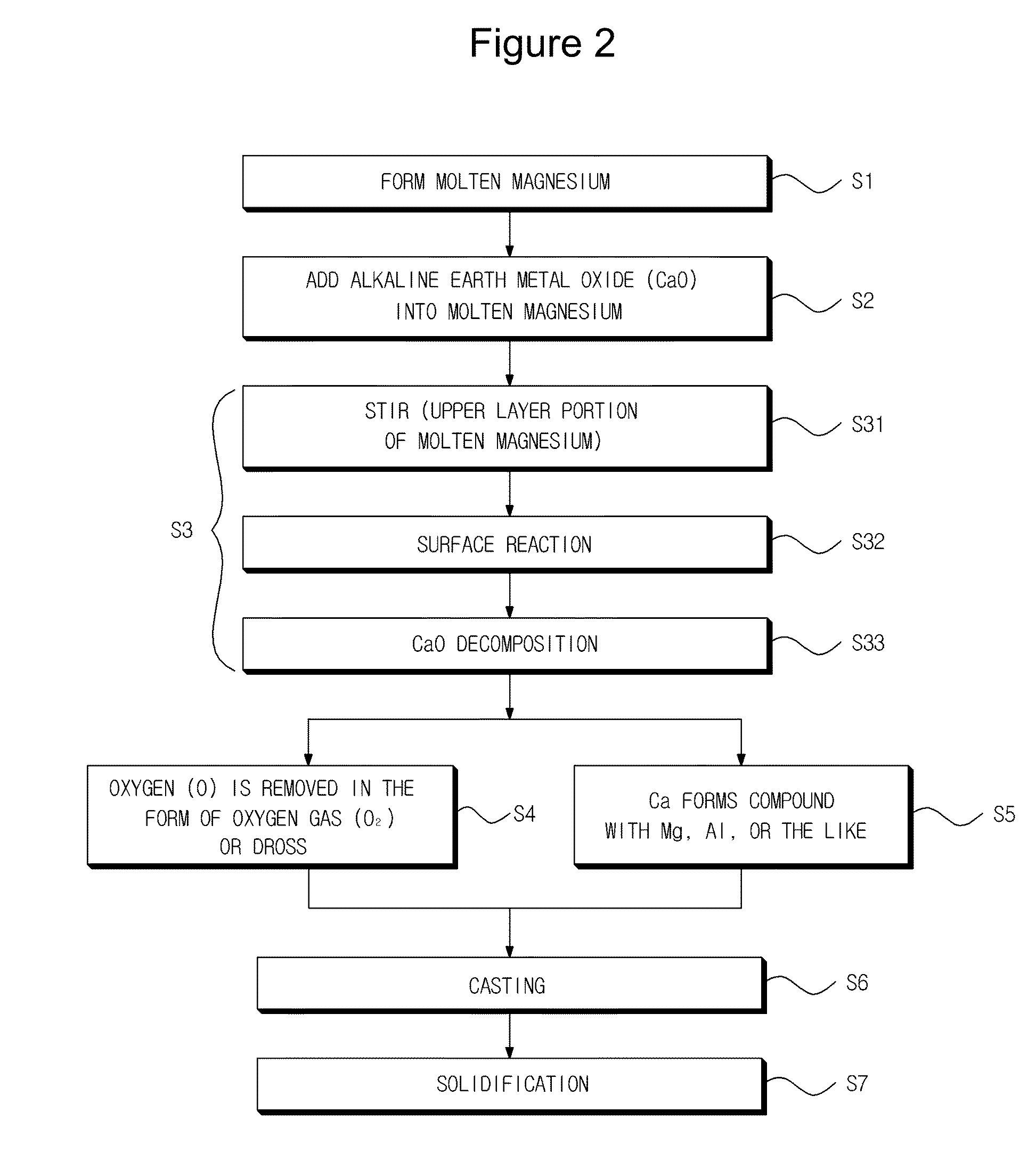Magnesium-based alloy with superior fluidity and hot-tearing resistance and manufacturing method thereof
a technology of fluidity and hot-tearing resistance, which is applied in the direction of thin material processing, transportation and packaging, etc., can solve the problems of poor castability of magnesium alloys, disadvantageous cost of magnesium alloys which have been developed based on the above requirements, and reduce the manufacturing cost of magnesium alloys. , the effect of reducing or removing a protective gas
- Summary
- Abstract
- Description
- Claims
- Application Information
AI Technical Summary
Benefits of technology
Problems solved by technology
Method used
Image
Examples
example 1
[0118]FIG. 7 is a graph showing room-temperature hardness of a magnesium alloy manufactured according to an embodiment of the present invention;
[0119]As shown in FIG. 7, it can be understood that the hardness of an AZ31 magnesium alloy with 1.5-12.5 wt % of CaO having a particle size of 100 μm added is increased as the added amount of CaO is increased. That is, the hardness of the AZ31 magnesium alloy into which CaO is not added is about at room temperature, whereas the hardness of the CaO-added AZ31 magnesium alloy is increased beyond 40.
[0120]The hardness versus the added amount (wt %) of CaO is shown in Table 4 below.
TABLE 4AlloyAdded amount of CaOHardness [Hv]Magnesium lloy1.5 wt %52(AZ31)3.7 wt %557.4 wt %5812.5 wt % 60
[0121]Therefore, as shown in Table 4, it can be understood that the hardness is continually increased when 1.5-12.5 wt % of CaO is added into the Mg alloy. Also, if the added amount of CaO is 12.5 wt %, the hardness is about 60 which is higher than the hardness o...
example 2
[0122]FIG. 8 is a graph comparing mechanical properties of a magnesium alloy manufactured according to the present invention with mechanical properties of typical magnesium alloys
[0123]As illustrated in FIG. 8, a magnesium-based alloy (AM60+CaO) manufactured according to the present invention is superior in yield strength (YS), tensile strength (UTS) and elongation (EL) to typical AM60 alloys.
[0124]For example, the typical AM60 alloy has the yield strength of 115 [MPa], tensile strength of 215 [MPa], and elongation of 6%.
[0125]However, the magnesium alloy prepared by adding 1.0 wt % of CaO into an AM60 alloy has the yield strength of 152 [MPa], tensile strength of 250 [MPa], and elongation of 8%, and thus have remarkably superior mechanical properties to those of the typical AM60 alloy.
example 3
[0126]FIG. 9 is a graph showing room-temperature hardness of a magnesium alloy manufactured according to another embodiment of the present invention;
[0127]As shown in FIG. 9, it can be understood that the hardness of an AM50 magnesium alloy into which 1.2-5.6 wt % of SrO having the particle size of 150 μm is added during manufacturing process is increased as the added amount of SrO is increased. That is, the hardness of the AM50 magnesium alloy into which SrO is not added is about 45 at room temperature, whereas the hardness of the AM50 magnesium alloy into which small amount of SrO is added is about 50 or more.
[0128]The hardness according to the added amount (wt %) of SrO is shown in Table below.
TABLE 5AlloyAdded amount of SrOHardness [Hv]Magnesium alloy1.2 wt %51(AM50)2.0 wt %533.8 wt %555.6 wt %57
[0129]Therefore, as shown in Table 5, it can be understood that the hardness is continually increased when 1.2-5.6 wt % of SrO is added into the Mg alloy. Also, if the added amount of Sr...
PUM
| Property | Measurement | Unit |
|---|---|---|
| particle size | aaaaa | aaaaa |
| specific gravity | aaaaa | aaaaa |
| temperature | aaaaa | aaaaa |
Abstract
Description
Claims
Application Information
 Login to View More
Login to View More - R&D
- Intellectual Property
- Life Sciences
- Materials
- Tech Scout
- Unparalleled Data Quality
- Higher Quality Content
- 60% Fewer Hallucinations
Browse by: Latest US Patents, China's latest patents, Technical Efficacy Thesaurus, Application Domain, Technology Topic, Popular Technical Reports.
© 2025 PatSnap. All rights reserved.Legal|Privacy policy|Modern Slavery Act Transparency Statement|Sitemap|About US| Contact US: help@patsnap.com



